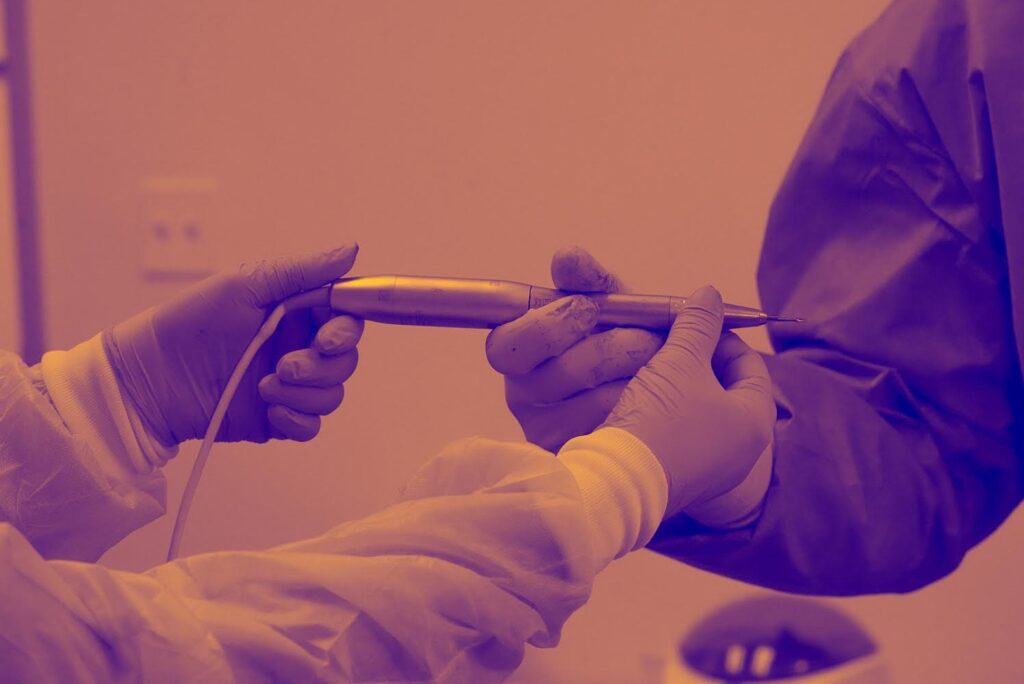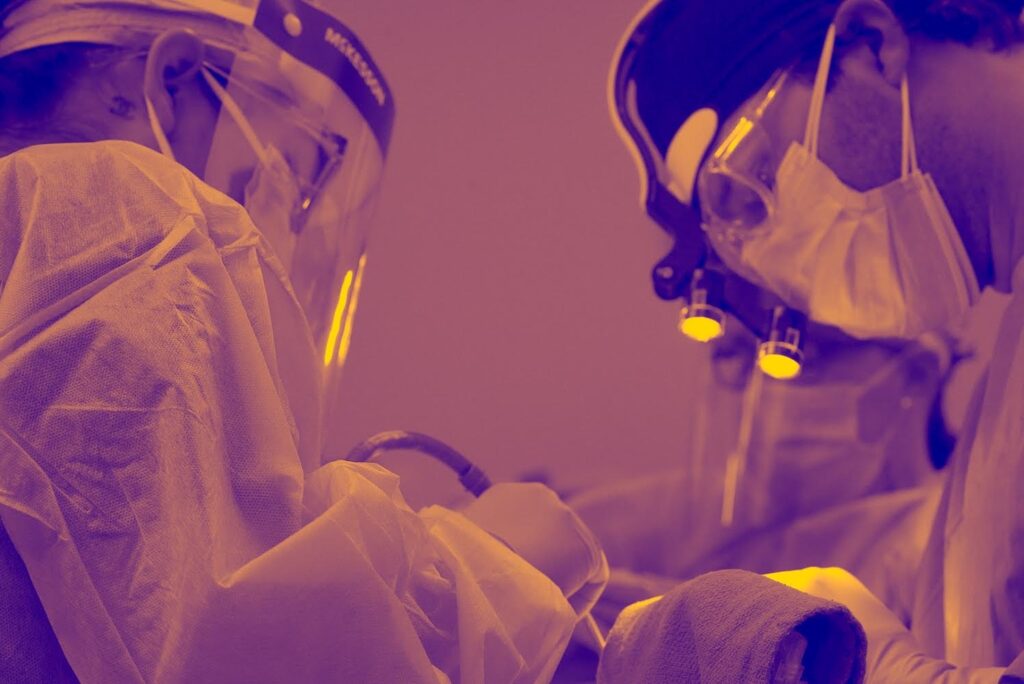I have had the opportunity to work with many exceptional All-On-X assistants over the years.
I have learned a great deal from these assistants that has shaped how I perform surgery today. This is especially true regarding the way in which I utilize my surgical team to optimize AOX efficiency.
Below are The Most Valuable AOX Lessons I’ve Learned from My Surgical Team.
1. Be confident. Don’t second guess yourself.
When I first began my AOX journey, I wasn’t incredibly confident, and for obvious reasons – I simply didn’t have much experience.
Nonetheless, after doing a few hundred arches, I still struggled with confidence. Relative to my experience, I should have been more confident in my AOX abilities.
However, like many new surgeons, I would second guess myself and hesitate intraoperatively.
When hesitation was sensed during difficult cases, my chairside assistant would ask me two questions,
“What do you want to do? What’s your decision?”.
While this does not seem like a big deal, these simple, straightforward questions taught me that making an educated, confident decision was important not only for me, but for my team. Everyone needed to know which direction we were going, and that we were heading that way confidently.
“Relax. Look around. Make a call”.
This is very, very important in AOX surgery and is a lesson that all AOX surgeons need to master at some point.
2. Never take your eyes off of the surgical field.
During my first AOX case with a newly hired, but very clinically strong AOX assistant, I felt all was going well.
However, as I began to reach for an instrument on the mayo stand, I felt a cold stare coming in my direction. I looked up and saw a perplexed look on my new chairside assistant’s face.
She looked at me and said, “What are you doing?”, sounding almost shocked.
I said, “Uhhhh… grabbing a periosteal elevator. Why?”
She responded without hesitation,
“You’re the surgeon. Do your job and let me do mine. I’ll pass you the instruments. You’re better if you focus on the surgical field”.
When she said it, I knew she was right. What she said made complete sense. From that day forward, I never grabbed my own instruments again. And I was a better surgeon for it – almost instantly.

3. Utilize your assistants to optimize efficiency.
If as the surgeon, I am going to truly focus on the surgical field, that means I need a well trained team to perform the plethora of intra-operative tasks happening around me.
My team has taught me the value of having two assistants in every AOX case.
They have also shown me the often overlooked benefit of having clear, well defined roles for each of those assistants. One assistant focuses on the surgeon and surgical field. The second assistant focuses on the “drill and implant” related tasks such as switching drills, opening and loading implants, and preparing abutments.
This division of duties is required to maintain a constant flow during AOX surgery.

4. Don’t be too proud to ask your assistants for help.
During my career, I have worked with a couple of chairside assistants who had assisted on many more arches than I had done up to that point. I learned quickly that asking an intra-operative question regarding what they had seen other experienced surgeons do in similar situations, was very valuable.
There were many times I would simply ask these assistants, “What do you think is the best course of action”? I didn’t always do exactly what they felt was indicated, but I absolutely valued their opinion and factored it into my decision.
I learned the immeasurable value in operating as team, not as an isolated surgeon.
While less common now, I do still ask my assistants intra-operative questions when indicated. I’ve realized that you can absolutely “operate by yourself”, but in the end it’s going to be a much more frustrating case and a less enjoyable AOX career.
That said, it takes time to teach and trust your team. This is not something I do on the first day. This level of trust develops over months and months of arches. When this level of trust is achieved though, a certain stress is lifted off your shoulders because you know you have someone you can rely on, helping you in the trenches each and every case.
5. Don’t rotate assistants.
This idea is the opposite of what virtually every practice owner does. This is also the opposite of what I thought was the best way to teach and train a team.
Despite the fact that virtually no one does this, my assistants have shown me that this is by far the best way to teach, train and utilize assistants in the AOX space.
Most surgeons will have anywhere from 3-8 assistants in their practice. They tend to rotate assistants through each surgical position.
The thought here, as I used to think, is that this rotation “cross-trains” everyone. Therefore, if someone is sick, or leaves the practice, someone else can step in. It is also thought to help keep assistants “mentally fresh” as their job changes throughout the day, or throughout the week.
While this system is good at creating a whole team of assistants that can work different jobs, it’s even better at creating a whole team of assistants that are “average” at a lot of things and “great” at nothing.
If you want to be great at something, you need to focus on that thing consistently, day in and day out. This is true whether you want to be the best chef, the best soccer player, or the best AOX surgeon.
This is no different for surgical assistants. In a surgery as complex as AOX surgery, with so many different moving parts and pieces, it’s unrealistic to think that shuffling assistants around and having them dabble in clinical positions will create an exceptional AOX assistant.
Just like the surgeon, assistants need focus, practice, and repetition.
You want the same people, in the same spots, day in and day out. They need to be the best at what they do, just like you do.
How do you accomplish this?
You select people for the surgical positions based on what they are drawn to and are interested in. They are going to be doing this over and over so don’t force someone into a position they don’t want. Then empower them to become the absolute best at that position and reiterate the importance of that surgical role.
The assistants I’ve worked with over the years are likely some of the most well trained assistants in the AOX space, and they know it. But they have worked at their position, over and over for hundreds and hundreds of reps.
6. It takes 3 months of daily AOX surgery to build a great AOX assistant.
In teaching and training new surgical assistants, with the help of my most experienced assistants, we have come to the conclusion that it takes about 3 months of daily AOX surgery to build a great AOX assistant.
While this volume may not be applicable to everyone, it is the honest truth that in my experience 3 months of daily AOX surgery is required before a new assistant knows their position well and the surgery is running smoothly.
This is yet another reason why I do not rotate my assistants. When training new assistants I keep them in either the chairside or in the #2 “implant related” position for 3 months, without moving them. During this time one of four things will happen:
- They will demonstrate a high aptitude and skill level for the position. Normally, if they are very good at that surgical position, they also tend to enjoy it.
- I will notice that for one reason or another, they are not thriving in the position and do not like it, but that they do show signs of surgical skill and ability. In this case, a change of position is discussed.
- They really like AOX surgery, but voice that they want to move to the other surgical position. If this is an option, we make this change – especially if the assistant is talented, focused and motivated. At a minimum, we eventually work them in to allow them to be the “cross-trained” assistant.
- They do not like AOX surgery and want to move back to the “prosthetic” side. Many assistants have not worked in an environment like AOX surgery day in and day out. Some simply do not like it. This is fine and this honesty is welcomed. There are plenty of prosthetic driven positions in our practice as well.
During these first 3 months, I’ll be honest, I may not be the most pleasant to work with intra-operatively. I’m focused both on the surgery as well as trying to ensure my assistants are performing at an optimal level and anticipating the next steps.
I tell new assistants that it will be 3 months before we can carry on a conversation during surgery. While this sounds over the top, I find it to be spot on. During the first 3 months, a conversation about the weekend or family tends to distract a new assistant from anticipating the next steps. After 3 months, they have developed muscle memory and they are able to assist at a high level, anticipate, and carry on a casual conversation. This is the point at which the surgery becomes more fun and relaxed for all involved.
Your team is incredibly important to your success. This is especially true intra-operatively in the trenches.
As surgeons we often think of what we can teach our team.
I challenge you, however, to take a step back and see what you can learn from your AOX team.
Remember, they have a front row seat to your surgery and often see things from a viewpoint that you don’t.
If you’re not careful, your team might just teach you something.
Matthew Krieger DMD
P.S.
In reference to point #5. I do always have at least one assistant that is cross-trained outside my “usual” team. They have just enough training in either position to step in if someone is sick.
Both of the “usual” surgical assistants also have just enough cross training to do the other’s job, should the need arise. However, the time spent “cross-training” is minimal, and is just enough for us to survive for a short period of time if needed. Otherwise, their focus is on becoming the best at their normal surgical role.


Love the point 4, keep your ego in check. Assistants are second set of eyes, use them.
Absolutely!